How to Store Bulk Meat for Maximum Freshness
Buying meat in bulk can save you money and time, but only if you store it properly. Improper storage leads to spoilage, food waste, and potential health risks. This comprehensive guide will walk you through the best methods for storing bulk meat, ensuring you enjoy its freshness and flavor for as long as possible.
What's the Best Way to Store Bulk Meat?
The optimal method for storing bulk meat depends on the type of meat and how long you plan to keep it. Generally, freezing is the best option for long-term storage, while refrigeration is suitable for shorter periods. Let's break it down:
Freezing Bulk Meat:
This is the key to preserving bulk meat for extended periods. Here's how to do it right:
- Portioning: Before freezing, divide the meat into portions suitable for your family's meals. This prevents freezer burn and makes it easier to thaw only what you need. Use airtight freezer bags or vacuum-sealed packaging for optimal protection.
- Labeling: Clearly label each package with the type of meat, date of freezing, and portion size. This helps with inventory management and prevents accidental spoilage.
- Freezing Techniques: For faster and more even freezing, lay the meat flat in a single layer on a baking sheet before transferring it to a freezer bag. This prevents clumping and ensures quicker freezing.
- Freezer Placement: Place the packaged meat in the coldest part of your freezer, ideally towards the back where temperature fluctuations are minimal.
Refrigerating Bulk Meat (Short-Term Storage):
If you plan to use the meat within a few days, refrigeration is an option. However, remember that it won't preserve the meat for as long as freezing.
- Packaging: Use airtight containers or wrap the meat tightly in plastic wrap, then place it in a sealed container or bag to further prevent moisture loss and bacterial contamination.
- Placement: Keep the meat at the coldest part of your refrigerator, usually on the bottom shelves.
- Usage: Use the meat within its recommended shelf life, paying close attention to any signs of spoilage (off-odors, discoloration, sliminess).
How Long Can You Store Bulk Meat?
The storage time depends heavily on the type of meat and the storage method:
- Beef: 3-5 days in the refrigerator; 6-12 months in the freezer.
- Pork: 3-5 days in the refrigerator; 4-6 months in the freezer.
- Poultry: 1-2 days in the refrigerator; 9-12 months in the freezer.
- Ground Meat: 1-2 days in the refrigerator; 3-4 months in the freezer.
How to Properly Thaw Frozen Meat:
Thawing meat safely is crucial to avoid bacterial growth. Avoid thawing at room temperature. Here are safe thawing methods:
- Refrigerator Thawing: This is the safest method. Place the frozen meat in the refrigerator and allow it to thaw slowly. Plan ahead as this can take several hours or even overnight, depending on the size of the portion.
- Cold Water Thawing: Place the meat in a leak-proof bag and submerge it in cold water. Change the water every 30 minutes to maintain a cold temperature. This method is faster than refrigerator thawing.
- Microwave Thawing: Use the defrost setting on your microwave. This is the quickest method but requires careful monitoring to prevent uneven thawing and potential cooking of the meat's exterior.
What are the Signs of Spoiled Meat?
It's essential to know the signs of spoilage to prevent foodborne illnesses. Discard any meat showing:
- Unusual Odor: A sour, foul, or putrid smell is a clear indicator of spoilage.
- Slimy Texture: A slimy or sticky surface is a sign of bacterial growth.
- Discoloration: Significant changes in color (e.g., turning gray or green) indicate spoilage.
- Visible Mold: Any visible mold growth should immediately lead to discarding the meat.
Can You Refreeze Thawed Meat?
While it's generally not recommended, you can refreeze thawed meat if it has been kept at a safe temperature (below 40°F or 4°C) and hasn't shown any signs of spoilage. However, it's best to cook the meat before refreezing to ensure safety and maintain quality. The quality might be slightly reduced, however.
How to Extend the Shelf Life of Bulk Meat?
Proper packaging and storage are essential for extending the shelf life of bulk meat. Consider these tips:
- Vacuum Sealing: Vacuum sealing removes air from the packaging, slowing down the growth of bacteria and preventing freezer burn.
- Using Freezer Bags: High-quality freezer bags designed to resist punctures and freezer burn are recommended.
- Proper Labeling: Clear labeling helps you keep track of the meat's type, date, and portion size, ensuring efficient inventory management.
By following these guidelines, you can confidently store bulk meat, minimize waste, and enjoy delicious, safe meals for weeks or even months to come. Remember, food safety is paramount, so always err on the side of caution when it comes to storing and consuming meat.

